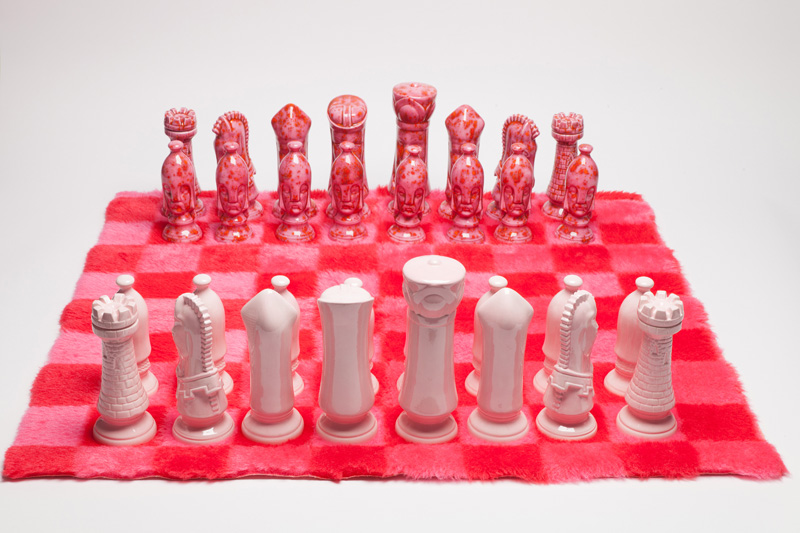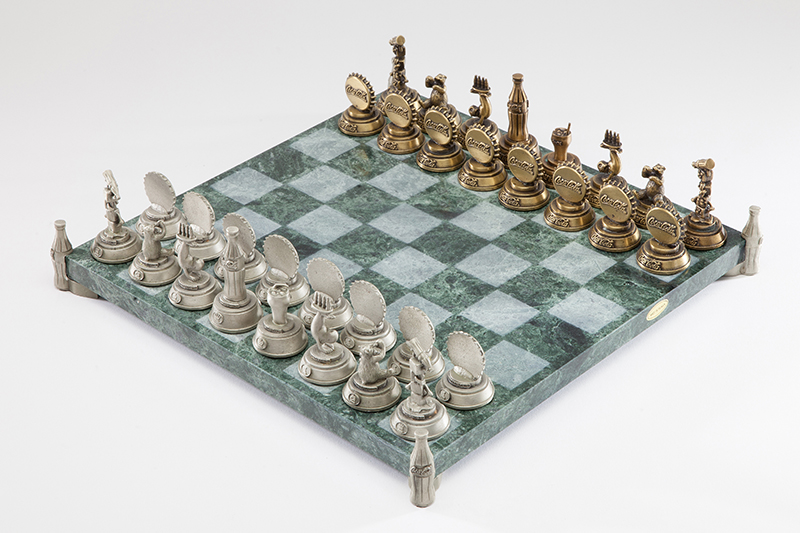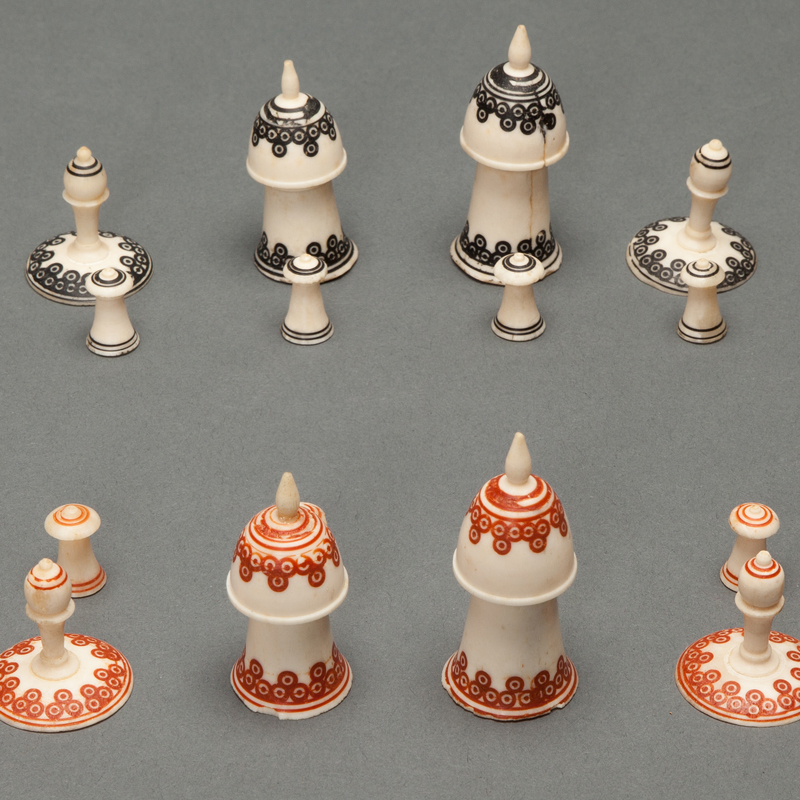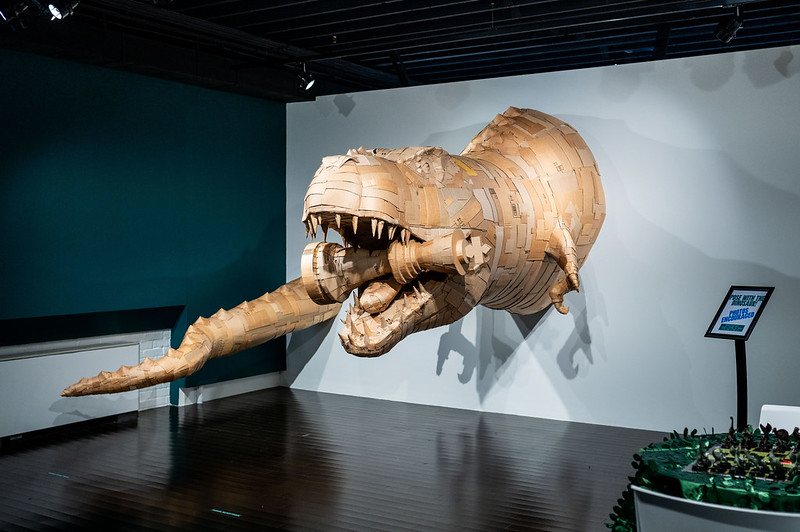January 1, 2017 - December 31, 2017
Featured Chess Sets 2017

Exhibit Overview
Through the Featured Chess Set project, the World Chess Hall of Fame showcases a variety of chess sets throughout the year. These include highlights from the institution’s collection as well as chess sets owned by Saint Louis metropolitan area friends and chess lovers who have special stories to accompany their sets.
Do you live in the Saint Louis metropolitan area and have a chess set with a great story? Submit it for inclusion in our Featured Chess Set project! This program highlights chess sets with interesting backgrounds borrowed from chess lovers and fans of the Hall of Fame. Featured chess sets are displayed for a period of one month at the World Chess Hall of Fame.
If you would like to participate in the program, send a photo and the story of the set to Emily Allred, Assistant Curator, at [email protected].
January

Al Ross
Falconry Chess Set, 2007
Pewter
King Size: 4 3/8 in.
Collection of the World Chess Hall of Fame, gift of John and Vicki Swift
Vicki and John Swift generously donated this month’s Featured Chess Set to the collection of the World Chess Hall of Fame. The pair met while John was the director of the Webster Groves YMCA, and they married 46 years ago. Vicki embraced John’s love of the sport of falconry, or hunting with birds of prey. Their shared passion for the sport has led them to collect falconry-related artwork like this chess set. The Swifts donated a second copy of this set to The Archives of Falconry in Boise, Idaho.
Artist Al Ross celebrates the history of falconry in this regal pewter chess set. Noble kings, queens, bishops, and pawns are depicted as falconers, while knights bear shields featuring images of bird of prey. A raptor perches atop a rook. Ross, an artist who created works with a variety of wildlife subjects, specializes in depicting birds of prey. His own experiences as a falconer since age 13 inspire these sculptures.
February

Duncan Ceramic Products
Ceramic Chess Set and Homemade Board, mid-1970s
Glazed ceramic and hand-cut fabric
Board: 30 x 30 in.
King size: 8 in.
Collection of the World Chess Hall of Fame, gift of Bobbie Glass
Bobbie Glass donated February’s Featured Chess Set to the World Chess Hall of Fame (WCHOF). Glass received the exuberantly colored set as a gift from a friend while in high school. The set, along with its accompanying hot pink and bright red shag carpet board, is part of the collection of the WCHOF, which features a diverse array of sets from across centuries and around the world, illustrating how chess has evolved over the course of its over 1500-year history.
This set, drawing its theme from medieval courts, was created using molds designed by Duncan Ceramic Products, Inc. (now iLoveToCreate). Founded by Erma Duncan, an artist with a passion for ceramics, the company was incorporated in 1955. At the time this set was designed, the company sold ceramic products for hobbyists, including molds, and established a national training program for ceramics teachers. Perhaps due to the rising popularity of chess in the United States during the era, the company copyrighted at least six designs for chess sets between 1965 and 1973. Hobbyists could customize the sets with paint or colorful glazes.
March

John Sever
The Husky Machine, November 2016
Machined and anodized aluminum, wood
King Size: 4 1/2 in.
Board: 21 1/2 x 21 1/2 in.
Collection of Husky Corporation

March’s Featured Set is on loan to the World Chess Hall of Fame courtesy of Husky Corporation. Husky has manufactured fuel dispensing equipment for 65 years and is based in Pacific, Missouri, which is in the Saint Louis metropolitan area. This set was designed with the same equipment and from identical materials used to create their fuel dispensing hardware. It was a commemorative gift for the 2016 shareholders of Husky Corporation.
This set repurposes industrial materials to create a set that is both charming and serves as a showcase for the products of its manufacturer. In the words of John C. Sever, Product Design Engineer for Husky Corporation, “One of my favorite features of this chess set is that each piece has some miniature machine functionality: the knight swivels on a live ball bearing race, the rook is spring loaded and can be ‘squashed’ by hand, the bishops incorporate an active thread that lets the player adjust their heights, and the pawns all include an external pipe thread that can be mated to the internal threads included in all the other pieces.”
April

Edward Lasker Chess Set, early 20th century
Boxwood, oak, birch, and walnut
King size: 3 1/4 in.
Board: 12 3/4 x 12 3/4 in.
Box: 7 7/8 x 5 x 2 1/2 in.
Collection of the World Chess Hall of Fame
April’s Featured Chess Set is part of the collection of the World Chess Hall of Fame (WCHOF). Since its creation in 1986, the WCHOF has endeavored to highlight the history and cultural significance of the game of chess. The WCHOF’s collection is diverse and includes sets once owned by legendary players, mass-produced sets with lively pop culture themes, antique ivory sets, travel sets, as well as chess computers. Through these artifacts, the WCHOF illustrates how chess has evolved through its over 1500-year history.
This simple chess set once belonged to Edward Lasker, the newest inductee to the U.S. Chess Hall of Fame. In 1914, Edward Lasker emigrated from Germany to the United States, where he soon became one of America’s top early 20th-century players. Lasker won five U.S. Open Chess Championships (1916, 1917, 1919, 1920, 1921), which were then known as the Western Open. In 1923, he challenged Frank Marshall to a match for the U.S. Chess Championship and narrowly lost, 8.5-9.5. Lasker also popularized chess through his books, which included Chess for Fun & Chess for Blood (1942).
May

Joe Larson
Robo-Action Chessbot Toy Chess Set (Hero vs. Monster)
2017
King size: 2 ⅜ in. (red), 2 ½ in. (black)
Chessbot Monster: 5 x 3 9/16 in.
Chessbot Hero: 5 ⅝ x 4 3/16 in.
3D printed plastic
Collection of the World Chess Hall of Fame
Joe Larson, known online as the “3D Printing Professor,” created May’s Featured Chess Set, which is part of the collection of the World Chess Hall of Fame. As a child, Larson had a dollar store chess set with plastic injection molded pieces with felt on their bases. When the felt fell off of the bottom of the pawns, he discovered he could fit the tops and bases of the pieces together. The concept of a chess set with interlocking pieces would eventually influence the creation of Larson’s Robo-Action Chessbot Toy Chess Set (Hero vs. Monster).
In 2012, Joe Larson became fascinated with the field of 3D printing. He entered a series of design contests with printers as the award, and finally won one in a contest sponsored by Makerbot and Tinkercad. Larson says, “I made a sketch on the bus of a Voltron-like robot with the pieces of a chess set forming its body. Then I set to work implementing that design in 3D. It took a week, and many design changes, but finally I had a chess set like no other. I won the contest and my first 3D printer.” The set is comprised of interlocking pieces that form battling robots when assembled.
June

Claire T.
Dogs vs. Cats
2017
King size: Dog 1 7/16 x 1 13/16 x 1 ¼ in., Cat 1 ⅞ x 2 ⅛ x ⅞ in.
Board: 18 ¼ x 17 ⅞ in.
Model Magic
Collection of Westchester Elementary
This month’s featured chess set is being shown courtesy of Westchester Elementary School in Kirkwood, Missouri. The school’s third grade classes use the game of chess as a means of learning about systems, or groups of interrelated parts that form a complex whole. Every year, each of the students learns how to play chess, and they take a field trip to the World Chess Hall of Fame and the Chess Club and Scholastic Center of Saint Louis. Following the field trip, each student created his or her own chess set.
An important family event—the adoption of a pet—inspired Westchester Elementary student Claire T. to create this adorable chess set. Each of the pieces represents a different breed, color, or fur pattern of cat or dog.
Dogs:
- King: Golden Retriever
- Queen: Goldendoodle
- Bishop: Labrador
- Knight: German Shepherd
- Rook: Husky
- Pawn: Cocker Spaniel
Cats:
- King: Calico
- Queen: Siamese
- Bishop: Rag Doll
- Knight: Red Tabby
- Rook: German Short Hair
- Pawn: Tabby
July

Mexico
Hand Carved Chess Set
2016
King size: 1 3⁄8 in.
Board: 7 9⁄16 x 7 9⁄16 x ½ in.
Marble
Collection of Emily Allred
July’s Featured Chess Set is on loan from the collection of the World Chess Hall of Fame’s Assistant Curator Emily Allred. She has worked at the institution since 2013 and has curated or co-curated a number of exhibitions including Prized and Played: Highlights from the Jon Crumiller Collection; Jacqueline Piatigorsky: Patron, Player, Pioneer; A Memorable Life: A Glimpse into the Complex Mind of Bobby Fischer; Living Like Kings: The Unexpected Collision of Chess and Hip Hop; Battle on the Board: Chess during World War II; Her Turn: Revolutionary Women of Chess; and the current exhibition Open Files II: Celebrating 5 Years of Collecting.
The World Chess Hall of Fame (WCHOF) often collaborates with Chess Collectors International, an organization founded in 1984 and dedicated to the study and promulgation of the art and history of chess artifacts. Since the WCHOF’s founding in 2011, the museum has hosted two meetings of the organization’s Western Hemisphere group. Their passion for collecting has inspired WCHOF staff, and many, like Allred, have started their own collections. Allred’s sister bought this set while on a trip to Mexico, and gave it to her as a Christmas gift. The board for the souvenir set has an inscription with the name of its country of origin.
August

Michael DeFilippo
Play Chess On the Moon
2017
2 1⁄8 x 23 9⁄16 in. dia.
Etched glass, joint compound, latex paint, and wood
Collection of the World Chess Hall of Fame, gift of Michael DeFilippo
During August, the World Chess Hall of Fame (WCHOF) is featuring this chessboard created by photographer Michael DeFilippo as part of its Featured Chess Set project. DeFilippo has been a professional photographer since 1983. He often photographs exhibitions and artifacts for the WCHOF. On August 21, 2017, the United States will experience its first total solar eclipse since 1979. Saint Louis, the home of the WCHOF, will partially be in the path of totality, or the path of the moon’s shadow, during the eclipse. This board has been chosen to be on view as a nod to the event.
This chessboard is inspired by Michael DeFilippo’s hobby of making ornamental topographic maps on the walls of his house. His bedroom now has a map of the Mediterranean Sea and his kitchen has a map of the Magnesian coast in Greece. DeFilippo uses a light gray drywall compound to create these maps, and a friend mentioned that this would be perfect for creating a map of the moon. He then experimented with creating a chessboard inspired by a NASA map of the moon. While he originally rendered the board directly on the moon’s surface, he found it competed with the moon’s texture. He finally settled on using etched glass for the board, which also conveys the low gravity of the moon, giving the sense that the pieces are floating.
September

John Waddington LTD.
Chessword
1972
King size: 2 11/16 in.
Board: 20 1/16 x 12 ⅜ in,
Box: 1 ½ x 12 ¼ x 10 7/16 in.
Plastic and cardboard
Collection of the World Chess Hall of Fame
Chosen for display in connection with the school year beginning, Chessword is one of many chess variants in the collection of the World Chess Hall of Fame. Like the 4th Dimensional Games set on view in Open Files II: Celebrating Five Years of Collecting, this chess-inspired game was sold in 1972, the year that American Grandmaster Bobby Fischer (U.S. Chess Hall of Fame, 1986; World Chess Hall of Fame, 2001) won the World Chess Championship. His victory popularized chess in the United States, leading many companies to produce unique variations on the game. Chessword features a game board with squares with letters. Players must move their pieces to different squares to get letters to spell a word to end the game rather than trapping the king in checkmate.
October

Denice Smith
Spooky Halloween Chess Set
2010
King size: 2 15/16 in. (Frankenstein’s monster), 3 ½ in. (Devil)
Board: 12 ⅜ x 14 5/16 x 3 ⅛
Wood, paint, clay, and cloth
Collection of the World Chess Hall of Fame, gift of Bernice and Floyd Sarisohn
Bernice and Floyd Sarisohn donated October’s featured set to the World Chess Hall of Fame. The Sarisohns share a passion for collecting chess sets, which began when Bernice gave one to Floyd as an engagement gift. In the years since, their devotion led them to become active members of Chess Collectors International, an organization founded in 1984 that brings together lovers of artistic chess sets and chess memorabilia. Their generous loans and donations have allowed the World Chess Hall of Fame to share a variety of wonderful sets with our patrons.
Gloomy ghosts, menacing monsters, and ghastly ghouls battle in a spooky dungeon in this Halloween-themed chess set. On the purple side, Frankenstein’s monster and the bride of Frankenstein serve as king and queen. The pair seem to be modeled on famous versions of the two monsters popularized in classic horror movies of the 1930s. The orange side is led by the devil and a witch, who mixes potions with a pestle made of a bone. The creator of this chess set took care to give each of the pawns individual expressions.
November

William T. Pinney
Pinney Club Size Chess Set
c 1930s-1950s
King: 4 11/16 in.
Wood and lacquer
Collection of the World Chess Hall of Fame, gift of Richard Kashdan
November’s Featured Chess Set, which was once owned by 1986 U.S. Chess Hall of Fame inductee Isaac Kashdan, is a new donation to the collection of the World Chess Hall of Fame (WCHOF). The set has been chosen in connection with the November 10 opening of the WCHOF’s newest exhibition Global Moves: Americans in Chess Olympiads. Kashdan was one of the top five chess players in the world during the 1930s. He represented the United States on five Olympiad teams, winning team gold three times and team silver once. He also earned two individual gold, one silver, and two individual bronzes. Kashdan later was the chess columnist for the Los Angeles Times and organized the Lone Pine International chess tournaments.
The unique knights in this American-made playing set are hallmarks of the distinctive chess sets made by Los Angeles-based manufacturer William T. Pinney. Pinney started creating chess sets following the closure of the Charleston Navy Yard, where he worked as a pattern maker. He developed his own machinery to create the sets, and his wife Katherine painted the black pieces with lacquer. Among the first individuals to mass produce chess sets in the United States, he advertised the unique sets in Chess Review. Some aspects of the designs of the pieces hinted at their movement—eight nicks in the knight’s mane indicate it can move to eight squares, eight nicks in the queen’s crown show that she can move in eight directions.
December

F.O.R.T.
Coca-Cola Collectors Edition Chess Set
1955
King: 1 7/16 in.
Board: 1 ½ x 10 x 10 in.
Pewter and marble
Collection of the World Chess Hall of Fame
December’s Featured Chess Set is part of the collection of the World Chess Hall of Fame (WCHOF). Since its creation in 1986, the WCHOF has endeavored to highlight the history and cultural significance of the game of chess. The WCHOF’s collection is diverse and includes sets once owned by legendary players, mass-produced sets with lively pop culture themes, antique ivory sets, travel sets, as well as chess computers. Through these artifacts, the WCHOF illustrates how chess has evolved through its over 1500-year history.
Polar bears, seals, and the iconic contour bottle—all recognizable aspects of The Coca-Cola Company’s advertising campaigns—are pieces in this chess set. Patented in 1915, the contour bottle was designed to be distinct from the bottles of The Coca-Cola Company’s competitors and recognizable even if dropped. Though polar bears first appeared in the company’s print advertisements in 1922, they are best known from a series of television advertisements that began in 1993 and were developed by Ken Stewart. Stewart modeled the bears’ behavior on that of his dog and worked with digital animation company Rhythm & Hues to create advertisements using computer animation. He later introduced the seals (another piece in this set) to the advertisements because the two animals are usually enemies. In the commercials, however, they bond over Coca-Cola.



















